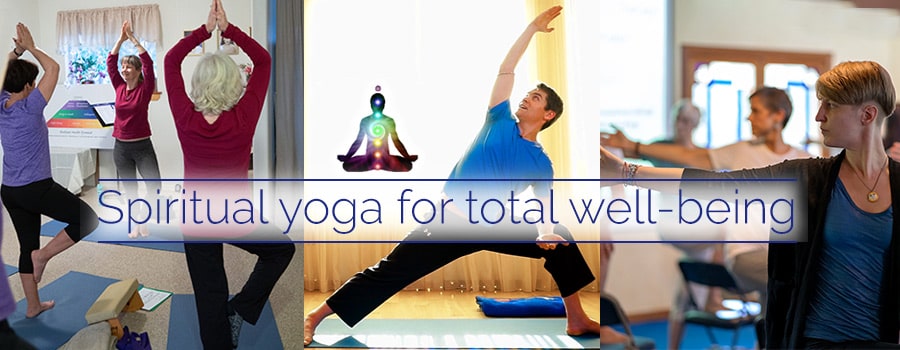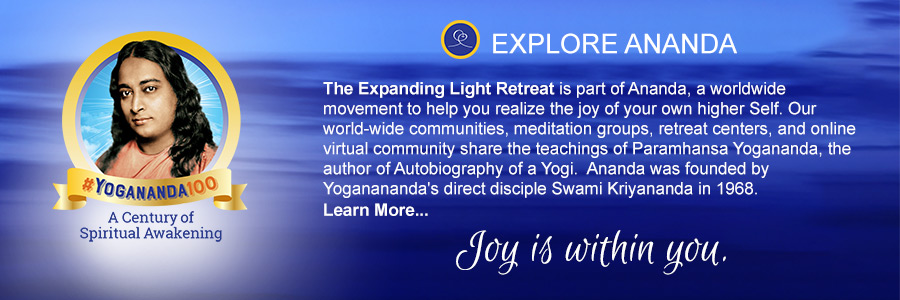|
This article was written for the Ananda Yoga® Teacher Association newsletter. Learn more, or find a certified Ananda Yoga® teacher near you. |
Tadasana, the Standing Mountain Pose
If you were going to develop an affirmation for tadasana, what would it be? On what quality would you focus? Why not go into the pose right now and think about it for a moment? Is it groundedness? We’ve all heard yoga teachers focus on using tadasana to get grounded, become stable, connect with the earth, etc. Certainly some people need to be more grounded, but I think that groundedness is the least aspect of Tadasana.
Besides, far too many people are far too earthbound due to desires and materialism. And I’ve never heard of a great master of yoga talking about drawing upon “earth energy” for upliftment of consciousness — whether in or out of an asana. Earth currents draw energy down into the body, which is good for healing, but not for lifting consciousness. That’s why yogis recommend meditating while sitting on fabrics (wool, silk, etc.) that will insulate us from those currents.
If not groundedness, what? Centeredness? Easy breathing and the free flow of prana in the spine? Relaxation? Certainly tadasana is great for all these, as Swami Kriyananda wrote in The Art and Science of Raja Yoga:
“Right posture is vitally important to the yogi. A bent spine impairs the flow of energy. It also cramps the breath, making it almost impossible to breathe deeply. Right posture, however, from a standpoint of yoga, is by no means the rigid stance of a soldier on parade. One must be relaxed even while standing straight. Indeed, until one can learn to keep his spine straight he will never know how to relax perfectly.
“Stand in such a way that you feel yourself centered in the spine, with the rest of your body suspended from the spine in much the same way as branches are suspended from the trunk of a tree. The chest should be somewhat (but not too much) out, the shoulders a little bit back, the head neither hanging forward nor drawn back too rigidly. If you stand perfectly straight, you will find that it takes very little strength to remain standing — only enough strength to maintain your balance.”
Nevertheless, Swami Kriyananda felt that these qualities are not at the heart of Tadasana. Nor is self-reliance, the point of his oft-quoted remark in Yoga Journal, “The most important yoga posture is the ability to stand on your own two feet.”
No, the affirmation that he recently wrote for it is, “I stand ready to obey Thy least command.”
First Reactions
The truth is, I really hadn’t been wishing for a tadasana affirmation. I’ve been using tadasana more to integrate the effects of the preceding pose than for its own sake. So I was a bit surprised to see this affirmation, and my first thought was, “It’s going to be very interesting teaching this to Americans” — who, as you’ve no doubt noticed, don’t like to obey anyone, including — and sometimes especially — God!
My next thought was that we teach tadasana on the first day of AYTT, when some of the students are wondering just exactly what they’ve gotten themselves into. They’d known before coming that they wanted a spiritual approach to Hatha Yoga, but for some reason it hadn’t registered with them that “spiritual” involves Spirit. So, this new affirmation is quite a baptism!
My third thought dissolved both the first two as well as my anxiety: “This is the perfect affirmation for tadasana!” And the deeper I went into it myself, the more I felt that way.
Think about it: What are we trying to do in yoga — not just in Hatha Yoga, but in, as I like to call it, The Big Yoga? It’s not just about getting grounded, or centered, or breathing more easily, or more being alert. All those are important, but the essence of yoga is to align our consciousness with God’s consciousness. More than just align with it — absorb ourselves in it. This takes receptivity, big time.
Expressing Receptivity
Then what better way to begin our asana practice than to plant the seeds of receptivity via both body and mind?
“I stand ready to obey Thy least command.” Stand tall with an open heart. Drop the postural habits and tension that make you feel heavy, inert, restricted. Enjoy the free, easy, natural flow of the breath. Try to feel the pulsating life-force in every cell of your body. Find the standing posture that makes your body — and more importantly, your consciousness — feel as light and open and free as possible.
In The Art and Science of Raja Yoga, Swami noted that when we stand or walk with our weight back on our heels, it makes our consciousness feel heavy. As we shift our weight forward toward the balls of our feet, our consciousness becomes lighter. Yet if we shift our weight too much onto the balls of the feet, tension creeps in — physically and psychologically — and the lightness diminishes. So find that intermediate point that enables you to feel the lightest on all levels. This balance, centeredness and lightness is the beginning of the pose, your foundation for receptivity, for cultivating that attitude that is so central to yoga: an attitude of intense inner opening and listening to God.
If some people balk because they see this as an attitude of meekly bowing down to some Cosmic Tyrant — that’s their problem, not God’s. After all, God is our own Self. Who would want to resist guidance from his or her own Self? It’s exactly what we all want! Therefore magnetically draw it to you: “I stand ready to obey Thy least command.” Affirm it in every limb, cell, atom, and filament of thought and feeling. Take it beyond mere verbal affirmation; make your body, mind and heart into living expressions of this attitude. Then you’re in tadasana.
Yes, the ego resists this attitude. When I mentioned to Swami that I thought this affirmation might raise some hackles — students’ as well as teachers’ — he got right to the point: “If it raises people’s hackles, tell them that that’s the ego complaining, which is just what we want to get out of. If not for our ego, who would have any objection to this affirmation?”
Tadasana Sets the Tone
Tadasana has a very special purpose: as the first pose of our routine, it sets the tone for all that will follow. And as the “neutral pose” between other standing poses, we keep coming back to tadasana over and over. Therefore it’s an extremely important pose — perhaps more important than any other.
I’ve come to understand that tadasana and its affirmation are not merely to be done once — or even many times — in the routine and then forgotten. No, together they should establish the bhav (spiritual mood, vibration) of the entire experience. This wordless vibration should resound through every aspect of our practice, infusing every asana and pranayama with its spirit of alert — even hungry — receptivity and willingness. Then we’ll feel the lifeforce more fully in all the asanas; we’ll experience the upliftment of consciousness more clearly in all the asanas; and our meditations will be filled with the magical spirit of receptivity.
All in all, what affirmation could be better for Ananda Yoga?
Yes, But…
I know that many of you teach in situations where you simply can’t say “God.” Perhaps your students aren’t ready for it. Perhaps you’ve chosen to reach out to a special group whom you knew from the start would not be open to God. Perhaps your employer would be displeased if you were to mention “God.” Or perhaps you’re not ready…
Whatever the case, it’s fine. Each teacher has to find his or her own way. Whether you need to avoid “the G-word,” or simply prefer to do so, the question is, What to do about the God-oriented affirmations? (By the way, many of the new affirmations refer to God in some way. Perhaps this is Swami’s way of keeping us pointed in the right direction, in the face of the widespread dilution of yoga that is occurring in the West at this time.)
Here’s a perspective that I hope will help: Don’t get into an “either/or” state of mind. It’s not a choice between using a God-oriented affirmation or using no affirmation at all. Nor is it a matter of “I’m into God” or “I’m not into God” — for you or your students. Rather, it’s a matter of direction: we’re all moving toward our own divine potential — consciously or unconsciously — and an Ananda Yoga teacher’s job is to help students move along their own paths. That means being sensitive to where they are and what they can relate to right now.
If this means modifying an affirmation, then do so in such a way as to match the spirit of the original. For example, “I stand ready to obey Thy least command” might become “I stand ready to follow the inner voice of wisdom.” Both of these affirmations share similar qualities of inward listening and readiness to respond — and as you know, it’s tuning in to the qualities that’s important, not the words themselves.
However, to my mind, the modified affirmation has neither the clarity of direction nor the power of the first. If that’s true, then the first affirmation would make it easier for a person who is comfortable with God to tune in to the quality of receptivity. It’s not about whether you use the word “God”; it’s about helping your students move toward the Self rather than the ego. For some people, “God” is too big a step. For others, “God” is the next step.
Can you think of a better modified affirmation? Quite possibly, but in any case I’d like to recommend that you not to let a modified affirmation become the default, the one you’ll use now and forever. Students will progress spiritually through their practice, even if you don’t emphasize the spiritual. Sooner or later, they’ll be ready for a “head on” approach to the Self, ready to experience more of the heart of yoga. Stay alert for that time so you can help them have that experience, help them draw upon the real power within them: the power of God. This is where that original, God-oriented affirmation will serve you — and them — by helping them open to a higher experience.
(By the way, I don’t want to give the impression that I think Swami’s asana affirmations are the only “real” affirmations, or the only powerful affirmations. Certainly there could be other good affirmations. Besides, since an asana might have more than one effect on one’s consciousness, it’s clear that there could be several good, but different, affirmations.)
So remember: even if your students aren’t yet ready for God-centered affirmations, someday they will be ready. In the meantime, do whatever you can to keep them moving away from ego-centeredness and toward the Self. If you stay “ready to obey Thy least command,” you’ll be keeping the channel open to understand intuitively how and when to help your students go into the deeper dimensions of their practice — and through that, toward their own divine potential.
Related Articles
All authors are graduates of Ananda Yoga Teacher Training.





















